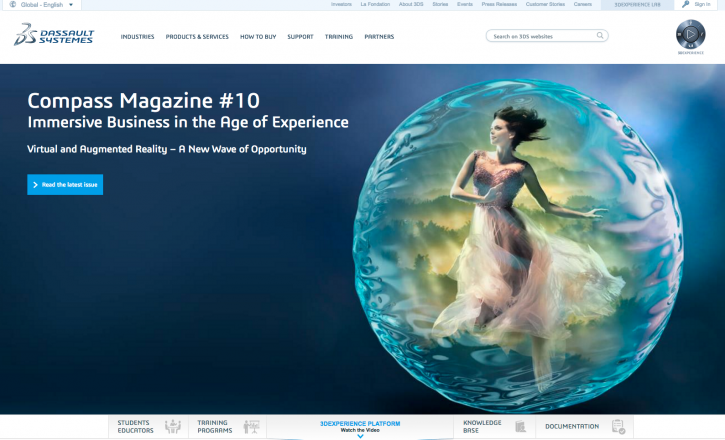Header Title
CATIA – from software tool to thought leadership
From CAD software to a whole idea about designing anything – and the difficulties of explaining it. The CATIA conundrum.
From one tool to the standard
One of the most significant long-term breakthroughs in the world of design for highly complex manufacturing is a multi-platform software suite from Dassault Systèmes in France, dubbed CATIA (an acronym of computer aided three-dimensional interactive application).
CATIA is used for computer-aided design (CAD), computer-aided manufacturing (CAM), computer-aided engineering (CAE) and 3D visualisation, and started out in 1977 as an in-house development by French aircraft manufacturer Avions Marcel Dassault to develop the remarkable Mirage range of combat aircraft. It proved so successful that it was hived off as a separate company in 1981.
Dassault Systèmes and the CATIA solution went on to become a market leader. This software is now used by a big wow roster of blue-riband companies in aerospace, automotive, shipbuilding, architectural design and other industries, including Airbus, Boeing, Bombardier, BMW, Mercedes, Honda, Porsche and Toyota. The US Navy, General Dynamics Electric Boat and Newport News Shipbuilding also used CATIA for the remarkable joint design of the benchmark-bending Virginia class of nuclear-powered fast attack submarines.
All in all, CATIA has turned out to be pretty much the prime iteration (thus far, obviously) of what used to be called CAD/CAM software, but has become so much more. It has become a “shared language” for 3D design and visualisation, as well as computer-controlled engineering and manufacture.
From “what” to “how”
This alters the communication agenda – much less about “what” the software is used for/what’s actually being built, and much more about impacts on the fundamental design thinking and the many business processes involved. It’s a shift from manufacturing to planning, from tangible to intangible as the base line, and to “getting it right first time” rather than traditional engineering kludges and “adjust when installing”.
Lurking behind the product specifics of CATIA is a design and engineering paradigm for considering and evaluating complex structures and installations, with a framework for innovation that merges multi-source know-how with a collaborative, co-creative approach to engineering as well as entrepreneurship and business in all their forms.
The discussion is no longer just about software and complex engineering installations – it involves a multi-faceted model for multiple companies to work together seamlessly on complex technology-based projects. That’s a seriously big mouthful, with loads of knock-on effects as well as opportunities. These include new conceptual frameworks for:
- Collaboration – companies from all over the world working directly on the same digitally structured project
- Decision-making – distributed decisions require new models for collaboration, delegation and empowerment
- Transparency – involving a lot of people/companies ups the ante for transparency and accountability
- Error prevention – multi-party development and know-how implementation need new responsibility models
- Quality assurance – “virtual” development involves new dimensions of preventive thinking/quality management.
Intangible ain’t easy
CATIA software from Dassault Systèmes has pretty much become the shared language for the 3D spatially distributed design used in advanced, complicated engineering projects optimised for subsequent manufacture and assembly. Most companies would give their right something-or-other to achieve a market position anywhere near on a par with CATIA.
Unfortunately, it seems as if Dassault Systèmes has difficulties with describing, establishing and asserting the kind of “thought leadership” that it’s been able to achieve. Here’s one of their key shots at laying out the corporate narrative/brand position. For a professional communicator, it’s almost painful to read.
Dassault Systèmes, the 3D experience company, provides business and people with virtual universes to imagine sustainable innovations
And here’s their headline attempt to describe what their main “product” actually does and delivers.
CATIA is the World’s Leading Solution for Product Design and Experience. It is used by leading organizations in multiple industries to develop the products we see and use in our everyday lives.
The spelling mistakes, grammar inconsistencies and clumsy wording only highlight how difficult Dassault Systèmes seems to find it to provide an adequate/convincing or aspirational description of what the company actually does and provides. Some of the key words may be OK in their own right but their sum total unfortunately seems just vague waffle, leaving a substantial dent in corporate credibility and a solid sense of missed opportunity.
The visual representation of what CATIA is all about (an example below) also seems to veer off into a seriously metaphorical morass. It’s paradoxical that one of the world’s leading providers of an immensely powerful tool for depicting, moulding and optimising 3D realities that don’t yet exist appears unable to conceptualise or visually depict its own thought leadership position.
Catching up
All these examples are only indicators of conceptual struggles definitely not limited to Dassault Systèmes. Of course, Dassault Systèmes has lots of good capabilities and ideas, including a 3DEXPERIENCE Lab that bills itself as a “new laboratory to nurture and empower disruptive projects”.
The real design problem now lies in presenting and explaining these ideas clearly and convincingly – and inspiringly, so that they can gel with new business models and entrepreneurial opportunities. Fortunately, industrial users do “get” it – of course. In early 2019, Airbus signed a five-year memorandum of agreement to implement Dassault Systemes’ 3DExperience platform to facilitate “collaborative 3D design, engineering, manufacturing, simulation and intelligence applications”. Guillaume Faury, president of the Airbus commercial aircraft business unit, was quoted as saying: “We are not just talking about digitalisation or a 3D experience; we are rethinking the way aircraft are designed and operated.”
Which seems a pretty clear summary of the game change involved.


